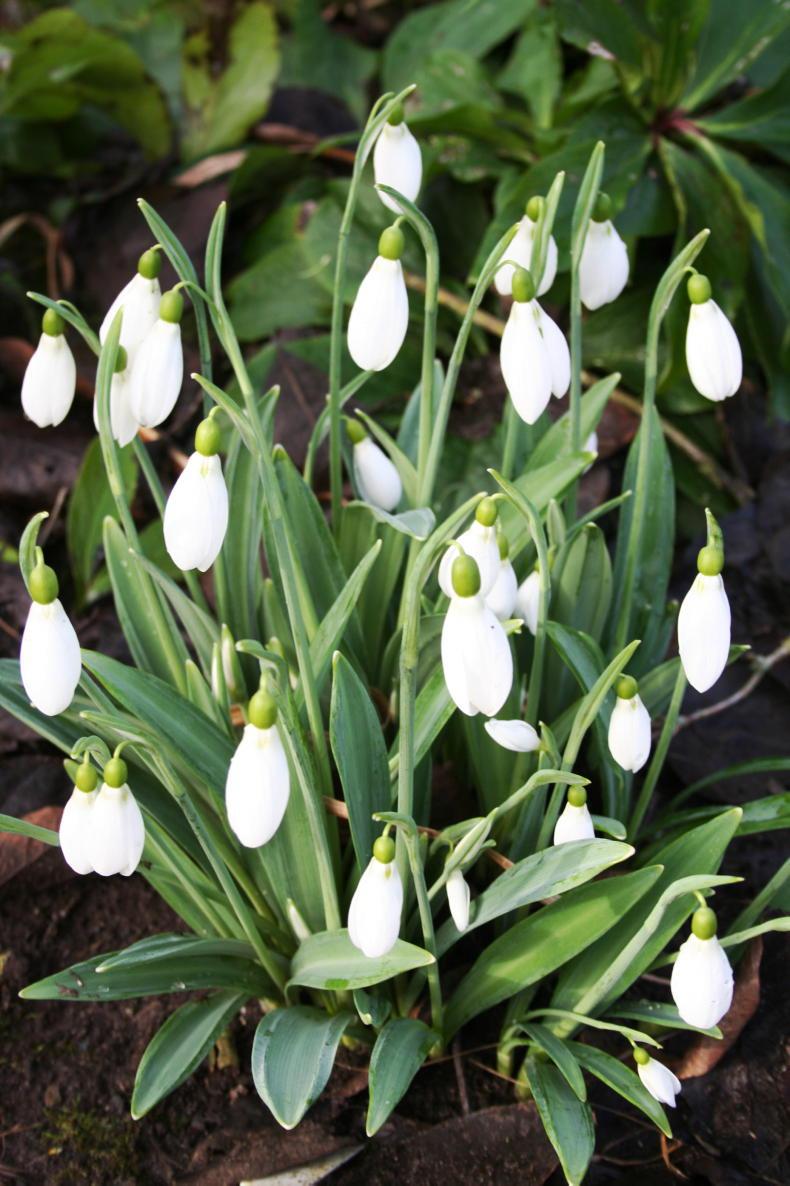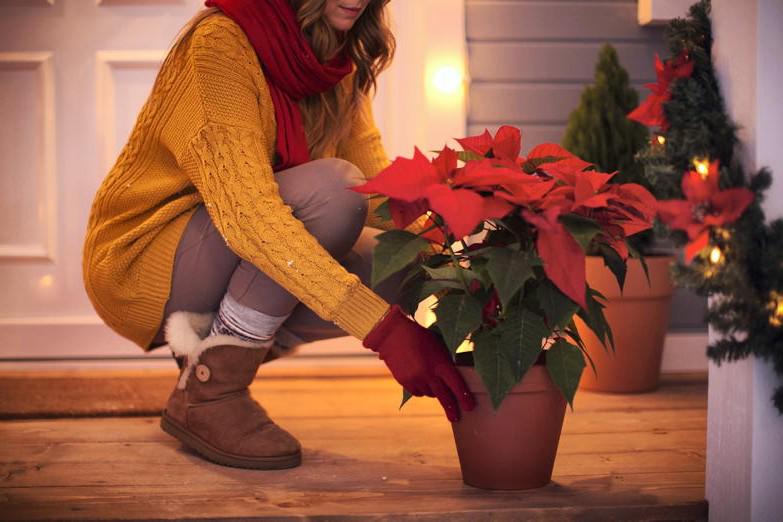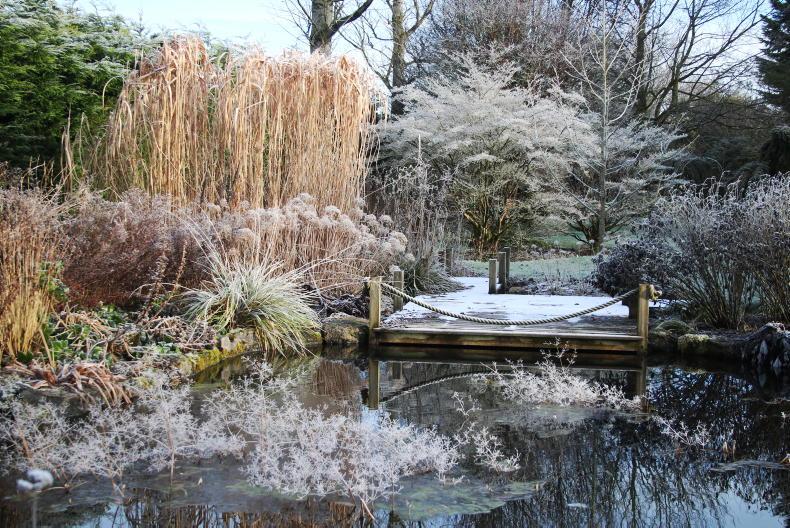Snowdrop flowers emerging from the cold ground are a welcome sign that spring is not far away, and this year many Irish gardens are filled with remarkably early displays. While some snowdrop species, such as Galanthus reginae-olgae, bloom as early as November, most flower between January and March.
From a distance, all snowdrops look pretty much alike. Closer inspection reveals subtle variations in flower size and shape, height of the plants, width of leaves and markings on the flowers. To most people, these differences are only mildly interesting, but some gardeners become so enthusiastic about building up collections that they have earned the name ‘galanthophile’.
Varieties
The common snowdrop, Galanthus nivalis, is excellent and the most affordable for mass plantings as it naturalises easily. Like all single-flowered snowdrops, it provides vital nectar for early-foraging bees. There are over 2,500 named snowdrop cultivars. Some are incredibly expensive, costing €10 to €50 per bulb, or significantly more.
If you are already growing the common snowdrop, you may want to expand your palette to include other cultivars. When starting a collection of snowdrops, one must-have and easy-to-find variety is ‘S. Arnott’, renowned for the delicious honey scent of its rounded blooms - that are almost twice the size of common snowdrops – on stems up to 25cm tall. It is a reliably robust and vigorous grower.
Amongst the modest collection of choice snowdrops in my own garden, one that stands head and shoulders above the rest is a superb Irish cultivar Galanthus plicatus ‘Woodtown’ raised by Mount Venus Nursery in Co Dublin.
Flowering earlier than most, the flowers are exceptionally large and well-shaped. Another Irish variety, Galanthus ‘Hill Poë’, is a lovely, double-flowered form that flowers late in the season. A favourite of mine is Galanthus elwesii; ‘Augustus’, with globular, lamp-like blooms and puckered petals that resemble white crêpe paper.
Most snowdrops can be planted straight into the ground but if you’re keen on growing some of the more precious varieties, plant the bulbs into pond baskets filled with a mix of John Innes no.3 soil-based compost, leaf mould and plenty of horticultural grit. Then, plunge the basket into the ground to help protect valuable varieties from being accidentally damaged by a sharp spade. Dedicated galanthophiles use these pond baskets to keep distinct varieties of snowdrop discreetly separate from each other in the garden. Made from an open mesh, black plastic, these are designed for water plants and are available from garden centres.

Galanthus plicatus ‘Woodtown’
Despite their delicate appearance, snowdrops are generally tough little plants which are quite easy to grow. They thrive in light shade under deciduous trees or shrubs, making beautiful companions for winter aconites, cyclamen and hellebores. As with most bulbs, snowdrops require well-drained soil which shouldn’t be allowed to dry out in summer. The ideal soil conditions replicate their natural woodland habitat: humus-rich and slightly moisture retentive. If your soil is very poor and thin, add organic matter to enrich it, and if it is heavy and doesn’t drain well, add grit to improve it.
Dry snowdrop bulbs planted in autumn often fail to grow or don’t perform very well because they may have dried out too much. Growing them from plants when they are in leaf, referred to as ‘planting in the green’, is usually a far better method.
Feed your snowdrops after flowering and before the foliage starts to die down. You can use a water-on liquid plant food or sprinkle on a slow-release feed. This will build up the bulbs’ strength and size for the following year’s flowering. Allow the foliage to die down naturally in spring.
When snowdrops are growing in a location that suits them, they will readily multiply and can eventually carpet large areas. Regular lifting and dividing will encourage them to thrive and is the easiest way to propagate them. Once the flowers have begun to fade, dig up the whole clump, shake off the soil and tease the bulbs apart with your hands. Re-plant half the clump in the same location and add smaller groups of three to five bulbs in random groups surrounding this central clump. Take care to replant them to the same depth by looking for the soil line on the stems.
Where to see snowdrops this spring: One of the longest established snowdrop events is the annual Snowdrop Gala taking place in Ballykealey House, Ballon in Co
Carlow on Saturday 27 January. Guest speakers include Steve Edney, fomer head gardener at the UK’s Salutation and Canterbury Cathedral, and Michael Dreisvogt, director of the Park Härle Arboretum in Germany.
Admission to this day-long event is €110 and includes teas, lunch, lectures, a guided tour of the snowdrop collection at Altamont Gardens and exclusive admission to a specialist plants sale in Altamont Plant Sales. Advance booking is essential. To book online visit altamontplants.digitickets.co.uk/tickets or for more information email hesterforde@gmail.com.
Altamont Gardens in Co Carlow is well known for its vast collection of snowdrops, with over 150 named varieties. The very popular Snowdrop Month at Altamont runs from 1-29 February with guided tours each Monday – Friday throughout February at 2pm. The gardens are open daily for general viewing from 9-4.30pm. For more information,
visit carlowgardentrail.com
Coosheen Gardens
• Snowdrop open day at Hester Forde’s Coosheen Gardens, Glounthaune, Co Cork T45CC42 on Saturday, 3 February (2.30-4.30pm). Guided tour at 3pm. Watch out for more details on Instagram @hesterforde or telephone 086 865 4972.
RHSI Bellefield
• Snowdrop weekend at RHSI Bellefield, Shinrone, Co Offaly R42 NW82 from Thursday to Sunday, 8-11 February (11-4pm). Tours with head-gardener, Paul Smyth at 12 noon and 2pm. rhsi.ie
Huntingbrook Gardens
• Join Jimi Blake for a guided tour of his snowdrop collection, which includes over 500 different varieties, at Huntingbrook Gardens near Blessington, Co Wicklow on 17-18 February at 11am and 2pm. Also 21-24 February at 11am each day. huntingbrookgardens.com
Ballyrobert Gardens & Nursery
• Snowdrop open days at Ballyrobert Gardens & Nursery, Ballyclare, Co Antrim BT39 9RT on 10 and 17 February (2-4.30pm). Booking is advised by telephone: 028 93440101 or email information@ballyrobertgardens.com.
Read more
Renewed energy
Mary Keenan’s Garden Diary: creating a warm, festive welcome
Snowdrop flowers emerging from the cold ground are a welcome sign that spring is not far away, and this year many Irish gardens are filled with remarkably early displays. While some snowdrop species, such as Galanthus reginae-olgae, bloom as early as November, most flower between January and March.
From a distance, all snowdrops look pretty much alike. Closer inspection reveals subtle variations in flower size and shape, height of the plants, width of leaves and markings on the flowers. To most people, these differences are only mildly interesting, but some gardeners become so enthusiastic about building up collections that they have earned the name ‘galanthophile’.
Varieties
The common snowdrop, Galanthus nivalis, is excellent and the most affordable for mass plantings as it naturalises easily. Like all single-flowered snowdrops, it provides vital nectar for early-foraging bees. There are over 2,500 named snowdrop cultivars. Some are incredibly expensive, costing €10 to €50 per bulb, or significantly more.
If you are already growing the common snowdrop, you may want to expand your palette to include other cultivars. When starting a collection of snowdrops, one must-have and easy-to-find variety is ‘S. Arnott’, renowned for the delicious honey scent of its rounded blooms - that are almost twice the size of common snowdrops – on stems up to 25cm tall. It is a reliably robust and vigorous grower.
Amongst the modest collection of choice snowdrops in my own garden, one that stands head and shoulders above the rest is a superb Irish cultivar Galanthus plicatus ‘Woodtown’ raised by Mount Venus Nursery in Co Dublin.
Flowering earlier than most, the flowers are exceptionally large and well-shaped. Another Irish variety, Galanthus ‘Hill Poë’, is a lovely, double-flowered form that flowers late in the season. A favourite of mine is Galanthus elwesii; ‘Augustus’, with globular, lamp-like blooms and puckered petals that resemble white crêpe paper.
Most snowdrops can be planted straight into the ground but if you’re keen on growing some of the more precious varieties, plant the bulbs into pond baskets filled with a mix of John Innes no.3 soil-based compost, leaf mould and plenty of horticultural grit. Then, plunge the basket into the ground to help protect valuable varieties from being accidentally damaged by a sharp spade. Dedicated galanthophiles use these pond baskets to keep distinct varieties of snowdrop discreetly separate from each other in the garden. Made from an open mesh, black plastic, these are designed for water plants and are available from garden centres.

Galanthus plicatus ‘Woodtown’
Despite their delicate appearance, snowdrops are generally tough little plants which are quite easy to grow. They thrive in light shade under deciduous trees or shrubs, making beautiful companions for winter aconites, cyclamen and hellebores. As with most bulbs, snowdrops require well-drained soil which shouldn’t be allowed to dry out in summer. The ideal soil conditions replicate their natural woodland habitat: humus-rich and slightly moisture retentive. If your soil is very poor and thin, add organic matter to enrich it, and if it is heavy and doesn’t drain well, add grit to improve it.
Dry snowdrop bulbs planted in autumn often fail to grow or don’t perform very well because they may have dried out too much. Growing them from plants when they are in leaf, referred to as ‘planting in the green’, is usually a far better method.
Feed your snowdrops after flowering and before the foliage starts to die down. You can use a water-on liquid plant food or sprinkle on a slow-release feed. This will build up the bulbs’ strength and size for the following year’s flowering. Allow the foliage to die down naturally in spring.
When snowdrops are growing in a location that suits them, they will readily multiply and can eventually carpet large areas. Regular lifting and dividing will encourage them to thrive and is the easiest way to propagate them. Once the flowers have begun to fade, dig up the whole clump, shake off the soil and tease the bulbs apart with your hands. Re-plant half the clump in the same location and add smaller groups of three to five bulbs in random groups surrounding this central clump. Take care to replant them to the same depth by looking for the soil line on the stems.
Where to see snowdrops this spring: One of the longest established snowdrop events is the annual Snowdrop Gala taking place in Ballykealey House, Ballon in Co
Carlow on Saturday 27 January. Guest speakers include Steve Edney, fomer head gardener at the UK’s Salutation and Canterbury Cathedral, and Michael Dreisvogt, director of the Park Härle Arboretum in Germany.
Admission to this day-long event is €110 and includes teas, lunch, lectures, a guided tour of the snowdrop collection at Altamont Gardens and exclusive admission to a specialist plants sale in Altamont Plant Sales. Advance booking is essential. To book online visit altamontplants.digitickets.co.uk/tickets or for more information email hesterforde@gmail.com.
Altamont Gardens in Co Carlow is well known for its vast collection of snowdrops, with over 150 named varieties. The very popular Snowdrop Month at Altamont runs from 1-29 February with guided tours each Monday – Friday throughout February at 2pm. The gardens are open daily for general viewing from 9-4.30pm. For more information,
visit carlowgardentrail.com
Coosheen Gardens
• Snowdrop open day at Hester Forde’s Coosheen Gardens, Glounthaune, Co Cork T45CC42 on Saturday, 3 February (2.30-4.30pm). Guided tour at 3pm. Watch out for more details on Instagram @hesterforde or telephone 086 865 4972.
RHSI Bellefield
• Snowdrop weekend at RHSI Bellefield, Shinrone, Co Offaly R42 NW82 from Thursday to Sunday, 8-11 February (11-4pm). Tours with head-gardener, Paul Smyth at 12 noon and 2pm. rhsi.ie
Huntingbrook Gardens
• Join Jimi Blake for a guided tour of his snowdrop collection, which includes over 500 different varieties, at Huntingbrook Gardens near Blessington, Co Wicklow on 17-18 February at 11am and 2pm. Also 21-24 February at 11am each day. huntingbrookgardens.com
Ballyrobert Gardens & Nursery
• Snowdrop open days at Ballyrobert Gardens & Nursery, Ballyclare, Co Antrim BT39 9RT on 10 and 17 February (2-4.30pm). Booking is advised by telephone: 028 93440101 or email information@ballyrobertgardens.com.
Read more
Renewed energy
Mary Keenan’s Garden Diary: creating a warm, festive welcome














SHARING OPTIONS